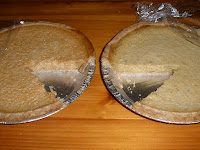A great deal has been written on the science behind
homebrewing. Any
homebrewer with a
speadsheet or calculator can figure to 1 degree where A pounds of grain at a temperature of B mixed with C quarts of water at a temperature of D will go when mixed. The
homebrewer will know to within a few ounces how much water can be drained, and what concentration of sugars should be expected. This is a good thing.
Many people like pumpkin ale. There are many recipes floating about, and much discussion of various techniques, but little has been written about how to calculate the effects of pumpkin in your mash. That bothered me enough to do something about it after I made a batch of pumpkin ale last week.
The PumpkinI bought a small (6" diameter) pie pumpkin at the local
greenmarket for $3. It weighed 2.41 lbs. After breaking off the stem, cutting it in half and scooping out the seeds, I had 1.76 lbs. That means that for a pumpkin of this size, about 1/4 is tossed before you begin.
The pumpkin was roasted at 350 F for 1 hour. The roasted pumpkin weighed 1.27 lbs, or 72% of its prepped,
pre-cooked weight. After the pumpkin cooled I scooped out the flesh and mashed it. The mashed pumpkin flesh weighed 0.94 lbs, or only 39% of it's market weight. But since I only need 0.5 lbs for the test, I'm OK.
The Mash2 lbs of standard 2-row malt at 70F were mashed with 0.5 lb pumpkin (20% of
fermentables) at 55 F and 3 quarts of water at 170 F. The mash went to 155 F. Since I knew the mass and temperature of all the components, I was able to calculate the heat capacity of the pumpkin. If water has a heat capacity of 1, and grain has a heat capacity 0.382, pumpkin has a heat capacity of 0.58. Using this you can calculate the exact strike water temperature you need for a given mash temperature. I had guessed that 170 F would be close, and let the mash cool to 153 F then kept it there for 90 minutes.
The
lauter was very simple. Since I had no plans to actually drink what I was making, I just dumped the mash into a strainer over another pot and let it drain. The resulting wort was cloudy and had plenty of grain particles in it. Had there been no pumpkin, I would have expected 3 quarts of water mixed with 2 lbs of grain to yield 2 quarts of wort. I was able to drain 2 quarts from the mash, so the mashed pumpkin did not seem to absorb any additional water. I had 0.5 gallons of 1.0774 wort.
The drained grain was then put back into the mash pot and mixed with 2 quarts of water at 170 F. After 10 minutes, the mash was drained into the pot with the first
runnings. I now had 1.0 gallons of 1.0541 wort.
The drained grain was put back into the mash pot one more time and mixed with another 2 quarts of water at 170 F. After 10 minutes, the mash was drained into the pot with the first and second
runnings. I now had 1.5 gallons of 1.0415 wort, or 62.3 total points.
2 lbs of standard 2-row at 36
ppppg have 72 total points. If no sugars were extracted from the pumpkin, I mashed at 87% efficiency. However, my typical efficiency is usually very close to 75-77%, which suggests that some sugar was extracted from the pumpkin. If I assume that my brute -force
lautering was able to get to 80%, then the malt would provide 57.6 points. That means that 0.5 lbs of pumpkin would have to provide 4.7 points, or that pumpkin has 9.4
ppppg (assuming 100% extraction). Based on the numbers from last week's pumpkin ale, and assuming that I had 75% efficiency, then I would have gotten 6.3
ppppg from the pumpkin (again assuming 100% extraction).
Perhaps what is needed is a repeat of the experiment without the pumpkin, to see what level of efficiency this method can produce.
 The rind of the cheese pumpkin is very pale when compared to the sugar pumpkin, but the flesh is much more orange. The roasted and mashed pulp of the cheese pumpkin is on the left. Both were roasted at 350 F for 1 hour, the scaped from the rinds and mashed with an electric mixer.
The rind of the cheese pumpkin is very pale when compared to the sugar pumpkin, but the flesh is much more orange. The roasted and mashed pulp of the cheese pumpkin is on the left. Both were roasted at 350 F for 1 hour, the scaped from the rinds and mashed with an electric mixer. The difference in color was also noticeable in the Bourbon Pumpkin Pie. Again, the cheese pumpkin is on the left. The recipe called for 15 oz. of pumpkin, a standard can size. The next time I make this recipe, I'll round it up to 1 lb and mix it in a blender to reduce any left over strings in the pumpkin. The taste difference, if any, is very subtle.
The difference in color was also noticeable in the Bourbon Pumpkin Pie. Again, the cheese pumpkin is on the left. The recipe called for 15 oz. of pumpkin, a standard can size. The next time I make this recipe, I'll round it up to 1 lb and mix it in a blender to reduce any left over strings in the pumpkin. The taste difference, if any, is very subtle.